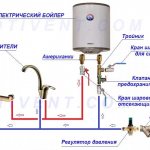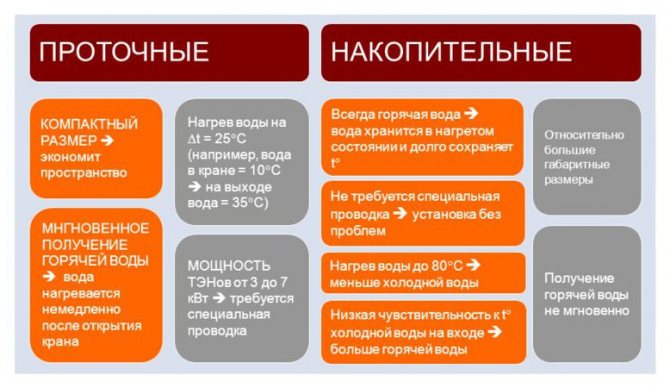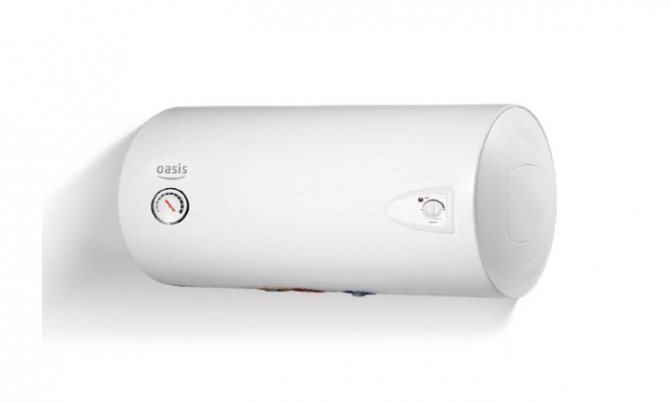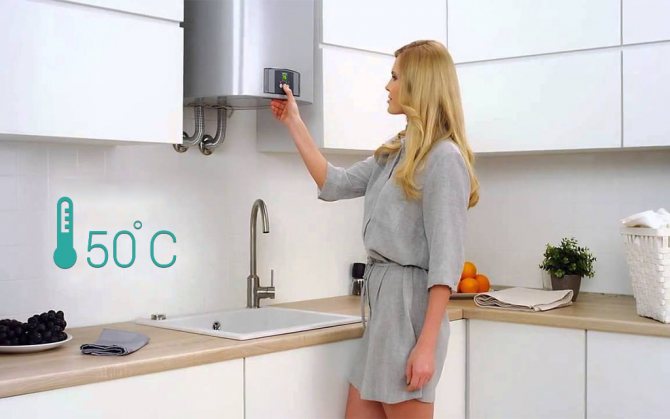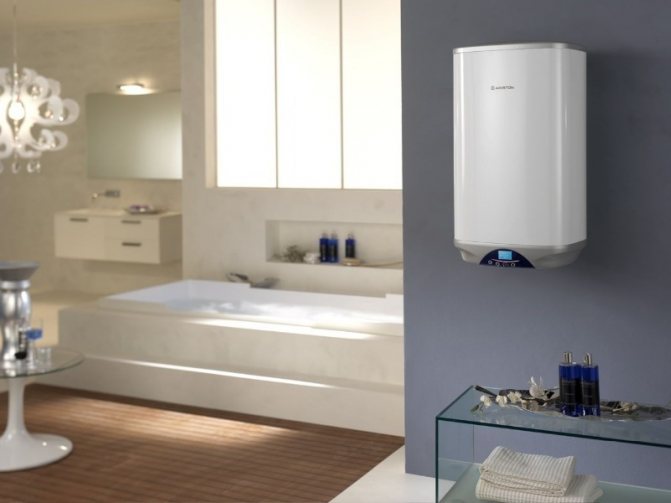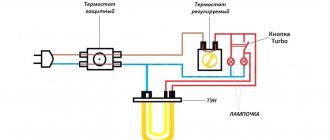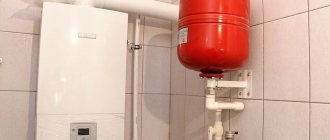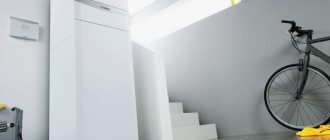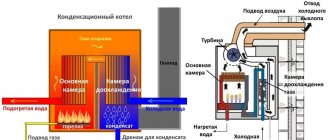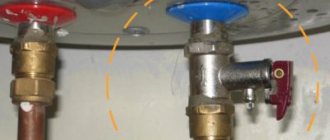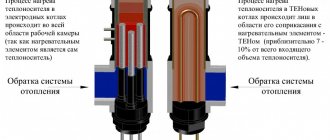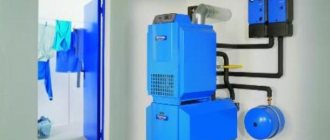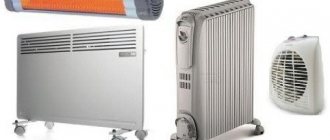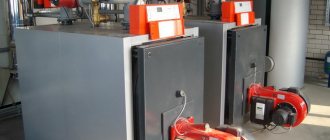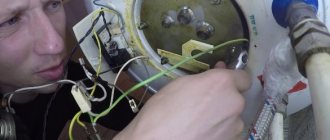The device and the principle of operation of technology
To rationally reduce energy costs, it is worth understanding the design of the water heater. It is designed as a stainless steel or steel tank with a layer of thermal insulation. Magnesium anodes are built into the steel tank to prevent corrosion and electrochemical reactions. A tubular heater with a thermostat is built into the tank. In the lower part of the tank there are pipes for supplying and releasing water. A thermostat and a thermometer are displayed on the front or bottom panel.
The device works as follows:
- Cold water is poured into the container through a hose with safety and return valves.
- The heating element turns on automatically and heats the water.
- When the contents of the tank reach the desired temperature, the heater is turned off using a thermostat.
- In models without a tap, the heating level is maintained in auto mode - the heating element turns on and off after a certain time.
- By opening the hot water supply tap on the mixer, water is taken from the upper part through a special tube.
Boiler installation and connection
An important role in saving light is played by the correct installation and piping of the household appliance. Before installing and turning on the water heater, be sure to read the operating instructions, especially if you decide to do this work yourself. We will give a few general requirements outlined in the manual for common Ariston units:
- to connect the water heater to the power supply, use a copper cable with a cross section of 3 x 2.5 mm²;
- the device must be grounded and powered by a separate line with an automatic two-pole switch, and not just insert the plug into the first socket that comes along;
- since the weight of a 50-100 liter boiler is quite large, fix it to a reliable base, for example, to a capital partition;
- mount models intended for vertical or horizontal installation in the indicated position;
- connect the unit to the cold and hot water supply network as follows:
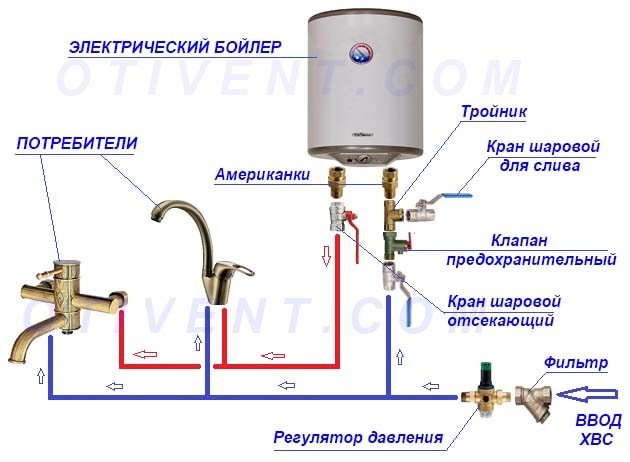
The piping diagram does not conventionally show the connection of the relief valve to the sewer
An important role here is played by a non-return valve, which does not allow the container to be emptied into the water supply system in the absence of pressure. It also acts as a fuse - it dumps water, which expands in case of overheating. Therefore, from the "spout" of the valve, you should pass a flexible tube into a plastic bottle or direct it to the sewer.
Above the valve, a tee with an additional drain valve must be installed. If the boiler is not used for a long time or there is a danger of freezing, then the water must be drained, and without a tap, this procedure becomes much more complicated. For the convenience of dismantling the device, the branch pipes are connected to the fittings through the American ones.
Advice. When it is not possible to attach the water heater to the main wall, make a simple metal support from 2 pipes and a strip, as shown in the photo.
Before turning on the boiler, you need to open the nearest DHW tap in the apartment and fill the tank with cold water until it flows out of the mixer. Then close the valve and start up the device.
Determination of the efficiency of a new water heater
How to start economically and correctly using a new boiler? Experts focus on determining its energy efficiency when purchasing.
General rules
Before purchasing equipment, the user needs:
- compare the energy efficiency of expensive and budget models in the store to establish the payback of the technique;
- to clarify that the energy efficiency class includes efficiency, losses per hour during heating and maintaining temperature, circulation. Information is indicated in the manufacturer's leaflet;
- take into account the capacity of the container, the speed of the heating element, the type of installation to clarify the total costs.
Interesting to know! On European models of boilers, energy efficiency has been indicated since 2013, on American models - since 2009.
Calculation of costs for annual operation
For calculations, you will need information about the energy efficiency class, type and cost of the coolant. Further calculations are performed according to the formula:
- for gas models, the number of days per year is multiplied by energy efficiency and the cost of a cubic meter of gas;
- for electric boilers, the number of days per year is multiplied by the energy efficiency and the cost of kWh.
Interesting to know! The DOE test for water heaters takes into account temperatures cold (15 degrees) and hot (60 degrees) and determines the performance of the device for a family of 3 people as 240 liters per day.
Heating element power as a saving factor
The more power of the heating element, the faster the water will heat up. Keep in mind that in houses with a single-phase wiring scheme, from 7 to 10 kW of power are allocated. A productive water heater will lead to an increase in the load on the network, huge energy costs and knocking out circuit breakers.
Repair of a water heater and the main types of breakdowns
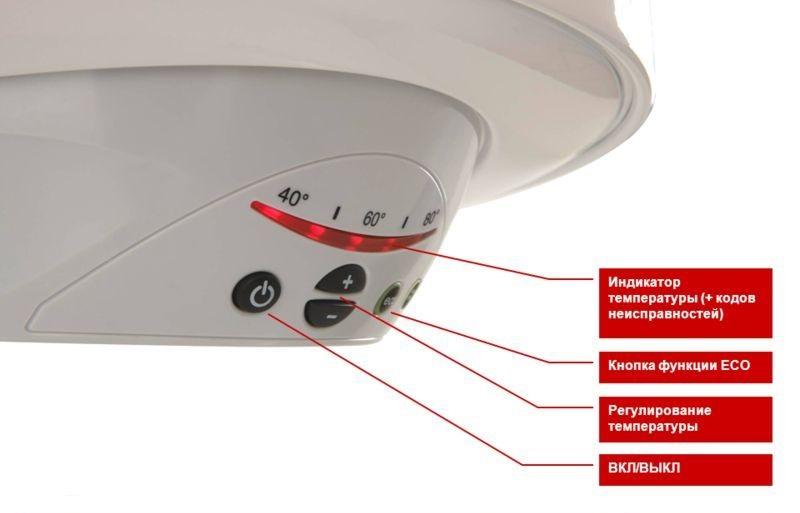

Functionality of Ariston models
Ariston gives a five-year warranty on hot water equipment, so you should not do repairs at home if it has not expired. When the warranty ends, the owner can do some repairs and service on his own once a year.
Ariston boilers are equipped with automatic diagnostic systems, information about faults is displayed on the display. Typical water heater problems that the user can deal with:
- scale;
- corrosion;
- water leak.
To prevent malfunctions, it is recommended to descale the thermal element with chemical solutions, change the magnesium anode and inspect the safety valve. Spare parts are sold at Ariston service centers.
How to use the boiler economically?
It is necessary to save with the included water heater during its operation, and not choose the most budgetary model. Users give many tips on how to really save the electricity consumed on a domestic boiler. Below is the TOP of the most effective ones.
Installation and connection for economical operation
There are some simple tricks:
- selection of a suitable place for installation. The long length of the pipe from the bathtub to the sink results in heat dissipation. In this case, more kilowatts are spent;
- activity setting. You can select the periods of activity and restart of the heating element. It won't save you a lot, but it's a good start;
- preventive cleaning of the heater. After descaling, the heating element will generate a sufficient amount of heat with minimal energy consumption;
- one temperature level. The maximum setting provides quick heating, but increases energy consumption. By selecting a heating program, you can reduce the amount of energy consumed.
Important! In older models of boilers in heating mode, efficiency decreases and they consume more energy.
Reducing hot water consumption
Is it only about energy? You will not understand how to economically use a domestic boiler if you do not calculate the water consumption. To raise the temperature of 1 liter of water, you need 0.001 kW / h of heater power. But this is easy to save on.
Scheduled activation
It is worth starting the boiler only when hot water is really required. It is better to wait for the device to heat up than to pay huge bills. The switching schedule depends on the volume of the tank:
- water heaters with a capacity of up to 50 liters can be turned off before leaving the house and turned on upon returning. The device spends 1-1.5 hours on heating, then it simply keeps the water hot;
- boilers for 80-100 liters take longer to heat up, consume a large amount of energy. It is enough to set the temperature to a minimum and turn on the standby mode.
Advice! Buy and set a timer - it will turn on heating 2 times a day by the selected time.
Preheating
How can you save on a running boiler in winter? At a temperature of water in communications of the central type of 6-10 degrees, more energy is required for heating. To reduce costs, you need to fill a container of 50-100 liters with warm water and put it in the boiler room. It will heat up in 8-10 hours.
Important! The method is suitable only for residents of private houses and involves the use of alternative heat sources.
The most economical boiler operating mode
Many manufacturers recommend using the boiler economy mode. It is marked with the letter "E". But at the same time, they do not specify what exactly is being saved. In this mode, the boiler heats the water by 55 0 C. But in fact, it will not be possible to save on the temperature difference. What are we saving then?
The economical operation of the boiler is, first of all, the slow formation of scale. At high temperatures, it forms much faster, and therefore it will have to be cleaned more often. To save on electricity consumption, it is better to use heated water to the end and turn off the boiler if it is not needed. But this is unlikely.
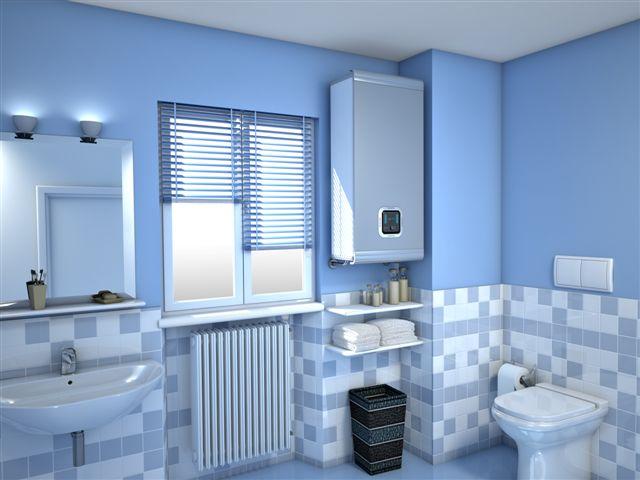

Having installed a simple device, like a temporary relay, you will be surprised how convenient it is to turn on the boiler more economically. The simplest models will help you set the time when the boiler will heat the water to the maximum temperature. For example, in the evening when the whole family is taking a shower. The rest of the time the temperature will be lower.
Energy efficient operation of water heaters
To eliminate overpayments for utilities, you need to figure out how to use a household boiler correctly and efficiently to efficiently save water and electricity. There are several ways.
Wastewater heat recovery
80 to 90% of the hot water energy is discharged into the sewer drain. The installation of the system allows using the heat of the waste liquid to heat the cold one. It is advisable to use 2 types of equipment in apartments and houses:
- with a buffer tank. Justified when using a washing machine or dishwasher. The effluent passes through a spiral tube in the reservoir, and their heat heats the water, which is pushed upwards. The water returns to the boiler in a preheated state;
- without buffer tank. A copper heat exchanger in the form of a spiral is wound on the sewer section. Preheated water is also returned through it.
Important! Depending on the intensity of use, the payback period for such equipment is 2.5-7 years.
Heat traps
When the heater pipes are connected to the top, the water rises and heats the pipes always. Convection loops conduct heat into the air where it is wasted. Installation of anti-convection ducts at the points where the pipeline is connected to the heater will increase the energy efficiency of the boiler.
Heat traps can be made by tying vertical pipes horizontally. To prevent the release of heat, plastic inserts are made at the joints of the pipes and heaters.
Lowering the water temperature in the water heater
There is a program selector on the outside panel. By setting the E (economical) mode, you will get water heating up to 55-60 degrees. The savings consist in increasing the resource of the heating element without consuming energy.
On the LCD panel, Eco mode can be programmed at a desired time. For boilers with mechanical control, just turn the knob.
Savings in the operation of the boiler provides a reduction in utility bills. There are many ways to improve the energy efficiency of your appliance. When choosing a specific option, be guided by the type of water heater and its displacement.
Almost every owner of this device knows how to use the boiler correctly, but the question is how to save energy on the boiler, without breaking the laws, know only a few. In this article, we will tell you how to save on hot water supply, and you will be able to rank yourself among those units of people.
Who is the indirect heating boiler suitable for?
Thinking over a hot water and heat supply system for your home, keep in mind that for a family with more than one person, instantaneous heating of water is ineffective and inconvenient. A set of a single-circuit boiler and an indirect heating boiler is more expensive than a double-circuit boiler and takes up more space, but has an undeniable advantage over the second - providing all residents of the house with hot water at a constant temperature. When using a water heating system based on heating running water, it is quite problematic to use two sources of water consumption at the same time (bathing and washing dishes, for example). At the same time, the water temperature is unstable and causes discomfort. An indirect heating boiler eliminates such problems. Firstly, the number of hot water consumption points is limited only by the volume of the boiler, secondly, the water in it is completely warmed up, and thirdly, hot water is supplied immediately after opening the tap and does not require waiting. How does the boiler work and work?
The indirect heating boiler is a cylindrical metal container for water storage. Depending on the model, it can hold tens or even hundreds of liters of water. You can choose a vertical or horizontal boiler. The former are mounted on the wall, the latter are installed on the floor. The body of the unit is mainly made of enamelled steel, and the use of stainless steel and plastic prolongs the life of the boiler, protecting the container from corrosion. Inside the tank there is a steel serpentine pipe (coil) of complex configuration, which makes it possible for the coolant circulating in it to heat the water as quickly and efficiently as possible. Some developers place the coils closer to the bottom of the tank, explaining that cold water is heavier and sinks to the bottom of the tank. Manufacturers are also experimenting with two heat exchangers: one coil is designed for circulating the coolant from the heating system, and the second for alternative heat sources (for example, a solar collector). But, regardless of how the boiler is arranged, the principle of operation is the same for all models and it is quite simple. Cold water enters the tank of the indirect heating boiler through one of the inlet pipes, the coolant circulates through the coil, which is heated by the boiler of the heating system, and the heat exchange process takes place. Through the outlet pipe, hot water enters the points of its consumption.
Methods to Reduce Electricity Costs
To do this, you must adhere to the following tips:
- Find the best place for installing the boiler. After all, if too large a pipeline runs to the sink or bath, then the heat will naturally dissipate, forcing you to spend more kilowatts.
- Choose the correct operating mode for the device. To save money, you need to correctly configure the active and inactive periods of the device, namely the heating element, you can save a small amount on kilowatts.
- Carry out preventive cleaning of the heating element (heating element). By cleaning it from scale, you can increase the efficiency of the element, namely, get the same amount of heat with less energy consumption.
By sticking to all these points, you can save a small amount of electricity, which will positively affect your budget.
See also -
How to clean a boiler yourself
Service measures to extend the life of the boiler
A significant amount of mineral salts are dissolved in the water entering the boiler. When the water is heated, they settle on the inner surface of the boiler tank and heating element (heating element). A similar effect is observed on the walls of an electric kettle when we use tap water without filtration. This sediment reduces the efficiency of the heating element, and thereby leads to an increase in the time for heating the water in the tank and, accordingly, the cost of electricity.
To prevent this sediment from appearing, modern boiler models are equipped with an anode. The anode softens the water around the heating element and prevents the formation of scale on it. The effect is achieved due to the fact that the pieces of the anode dissolve in water. Therefore, the service life of the anode is limited and is up to two years (depending on the water hardness), after which it should be replaced with a new anode. The photo below shows images of the new anode and anode after two years of operation.
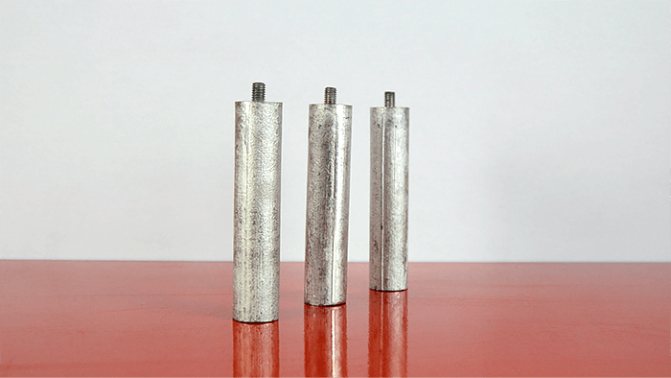

It is better to entrust the replacement of the anode to a specialist. He will not only qualitatively install the anode of the required model, but will also carry out the necessary maintenance of the components of the boiler and, if necessary, replace other elements whose service life has expired. By the way, service for boilers with "wet" heating elements is required annually, and for boilers with "dry" heating elements, specialist services will be needed every 2 years.
We will help you find the right product
We have created a smart filter so that you can quickly and easily find the right equipment.
- Water heaters
Volume liters
Heating element type
Water heater shape
1 Volume liters
Select suitable ranges
20 liters per person - the minimum rate for calculating the required volume of the boiler.
Recommendation: use two-tariff electricity meters - this will significantly save on heating water, especially if you have a large-volume water heater.
2 Type of heating element
Select the type of heating element
Dry heating element is a heating element protected by a metal flask from water (modern heating element does not come into contact with water). Wet heating element - a classic copper heating element, called "wet", as it comes into direct contact with water (tested over the years).
Recommendation: Dry ceramic heating elements with Steatite technology deserve special attention.
3 Tank shape
Choose the right shape of the water heater
Flat - the depth of the water heater is from 24 cm to 35 cm.
Rectangular - rectangular boiler.
Narrow - cylindrical water heater with a depth and width of 21 cm to 45 cm.
Cylindrical - a classic water heater, barrel-shaped.
Recommendation: cylindrical ones are the most optimal for the price, and flat ones are ideal for a small bath.
Choosing the right place to install the boiler
When you open a tap with hot water, you will most often have slightly warm water pouring out from there. Why is that? You may ask, since the liquid inside the heat exchanger is hot and there is no doubt about that, however, the boiling water must reach the tap, having previously displaced the cold liquid in the pipe. In a pipe 1 meter long and half an inch in diameter, due to the loss of temperature, it will be necessary to cover the loss of 200 milliliters of fluid.
After the valve on the tap was closed, you lose the same volume of warm liquid, because the "unused" liquid will remain in the pipes until the next opening of the valve. It can be concluded that every time you use a tap, your boiler consumes at least 400 milliliters for each running meter of pipe.
This cost can be optimized by reducing the length of the pipeline. Simply put, it is necessary to install the water heater in such a way that it is located in the middle of the kitchen and bathroom, but it is worth noting that it is better to make the kitchen branch shorter than the one that goes to the bathroom. After all, you turn on the tap in the kitchen much more often than in the bathroom.
However, not always the “suitable place”, which will significantly reduce costs, is ideal from the aesthetic point of view, and even more so from the convenience of use. After all, think for yourself, not everyone will be able to endure an eye-catching water heater located, for example, in the corridor. Yes, and not every owner of a water heater will dare to install it in an inconvenient place for him.
Indirect heating boiler for heating and hot water supply.
The degree of comfort in our life is firmly connected with such an integral element of civilization as the constant availability of hot water - to wash dishes, wash, wash ourselves. In urban conditions, hot water is more or less present in taps, but in the vast expanses of rural areas with hot water supply problems - it goes only to heating houses, circulating in heating systems with single-circuit boilers. The option of providing households with hot water using electric heating boilers is not very attractive - electricity is not cheap, gas boilers or, more commonly, gas water heaters have impressive dimensions and are not able to maintain a constant water temperature. The best option is an indirect heating boiler.
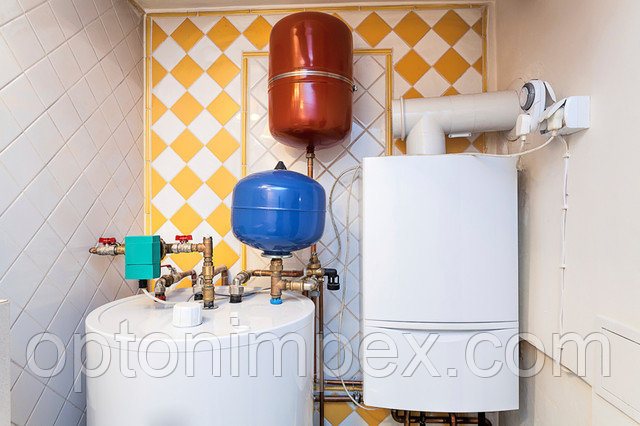

Why do you need an indirect heating boiler
An indirect heating boiler is purchased together with a single-circuit boiler - together this equipment takes up more space and is more expensive than a double-circuit boiler. However, their important advantage over a double-circuit boiler is the ability to provide households with a significant amount of hot water practically without interruption, while its temperature will remain unchanged.
Any water heating system based on heating running water has two negative factors - its performance is sufficient only for one or two points of water consumption, while the water temperature is not constant. For example, household members will not be able to wash the dishes and, say, take a shower at the same time, without experiencing a lack of water and a sharp drop in its temperature, which is very unpleasant. We have to develop a certain internal schedule for the consumption of hot water - if someone intends to take a shower, then he has to inform the other residents of the house about this and ask them not to turn on the hot water tap and cause unexpected discomfort to the bather.
In families with a number of households of 2 or more people, instantaneous water heating systems will be ineffective, a more optimal solution is an indirect heating boiler.
When using an indirect heating boiler, the number of simultaneously used hot water points is limited only by the capacity of the boiler - hot water is already collected in it and has the same temperature throughout the volume, that is, you do not have to wait until the water circulation when opening the tap delivers hot water of the required temperature ...
The device and principle of operation of the indirect heating boiler
Externally, the indirect heating boiler resembles a metal barrel for collecting water and has a cylindrical shape, it can hold either tens or hundreds of liters of water - the exact volume depends on the specific model. There are boilers like verticaland ghorizontal installations - the first type is attached to the wall at a certain height from the floor level and is preferable if the boiler room is small in area. The body of the storage tank is made of enamel painted steel, plastic and stainless steel - the latter two materials provide a significantly longer service life, since they are not subject to corrosion.
1 - cold water inlet (DHW); 2 - tubular heat exchanger; 3 - coolant outlet; 4 - coolant inlet; 5 - hot water outlet (DHW)
The serpentine pipe of a heat exchanger made of steel or brass, installed inside the tank of an indirect heating boiler, often has a complex shape, which allows the coolant circulating in it to heat the water better and faster. The coils of the heat exchanger can be located closer to the lower part of the boiler tank, where a colder layer of water accumulates, or be evenly placed throughout the entire volume of the tank - according to manufacturers, this arrangement allows for better heating of water, achieving a uniform temperature. There are models of boilers with two tubular heat exchangers, the first of which is designed for the circulation of the coolant from the heating system, the second for the coolant from other sources, for example, a solar collector or a heat pump.
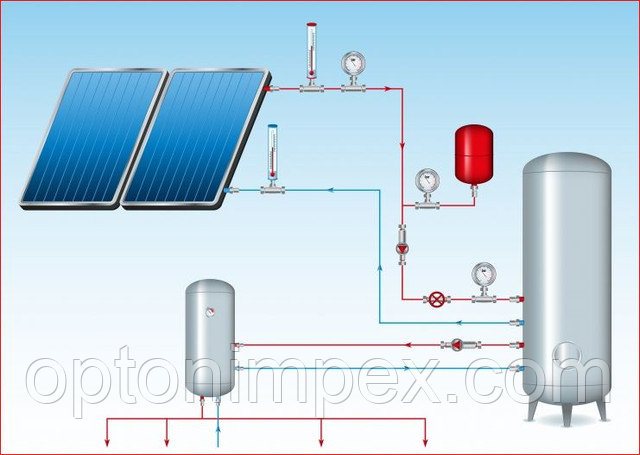

In addition to boilers with built-in coils, models are produced without heat exchange tubes - such indirect heating boilers consist of two tanks installed one into the other, the inner one is made of stainless steel, and the coolant circulates between the walls of the outer and inner tanks.
We select the correct mode of operation of the device
Most often, when the conversation comes to saving electricity among boiler users, they are divided into two camps. The former argue that the boiler must always be connected to the network in order to obtain the necessary hot water at any time. The latter argue that it is necessary turn off the boiler during the inactive stage and only turn on for -5 hours a day in order to heat the water.
So: in this matter, everyone is mistaken. You will in some way not be able to save on electricity by turning off the boiler, brought to the maximum temperature, and accordingly, you will not get any benefit.
Changing the power supply model of the heating element can save energy costs only if there is no hot water in the device at all. You don't want to take a cold bath or wash dishes in ice water, do you? You were not counting on such economic benefit.
However, don't be upset. In order to understand how to save money on a boiler, it is necessary to recall the Fourier's law of thermal conductivity, in which it is interpreted about the relationship between the energy absorbed during heating and the temperature difference of the incoming stream.
It follows from this that the achievement of a minimum difference between the temperature of the liquid that enters the tank and that already there, the less energy is needed in order to heat up the mixed liquid.
Simply put, by lowering the temperature of the boiler from 85-90 degrees to 55-60, you can safely use the boiler around the clock for a flight and save much more energy than constantly turning off the water heater, which worked at maximum. By reducing the temperature to 55-60 degrees, you will significantly slow down the process of scale formation on the heating element, due to a decrease in the thermal power of the device.
Selecting the operating mode of the equipment
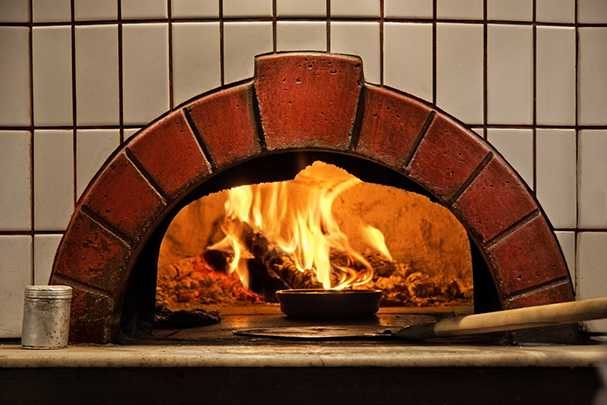

Very often you can hear disputes about exactly how to use a water heater in order to save the maximum amount of electrical resources. Typically, two opinions are expressed in such a debate. Some people think that the best way to save money is to turn off the boiler when it is not in use - usually at night. As an argument, the fact is used that, when turned on, the device periodically heats the water to the set level, thereby consuming energy for nothing.
The second opinion is directly opposite to the first one - you should always keep the water heater "at maximum", that is, with heating mode up to 80–90 degrees. However, usually the appeal goes not so much to savings as to the need to maintain the sanitary and hygienic condition of the tank at the proper level.
In fact, both opinions are not entirely correct. The first approach will entail two troubles at once. Firstly, in the morning you will wait a long time until the entire volume of water in the tank heats up, or you will have to wash yourself with cold water. Secondly, such heating will consume much more energy than maintaining the temperature. In this way, you simultaneously get the absence of both savings and comfort.
As for maintaining a high temperature in the tank to kill bacteria, there is some truth in this. Microorganisms in water are highly dependent on the state of the environment. At a relatively low temperature - from 30 to 40 degrees - they feel great, actively reproduce. The consequence of this is the formation of mold in the tank, as well as harm to human health. For example, the latter effect can be caused by the bacterium Legionella. If you take a shower using water saturated with it, then sooner or later you can get sick.
The same bacteria are still alive at temperatures from 50 to 60 degrees, but they no longer multiply and generally do nothing - in other words, they fall into deep sleep. And at 90 degrees they are completely destroyed. Thus, the best option for using the water heater modes is as follows:
- 50-60 degrees - for everyday use,
- 80-90 degrees - once a week to disinfect the tank. In this mode, you need to hold the equipment for a couple of hours, and then transfer it to everyday mode.
You do not need to turn off the water heater at night. When using the above modes, you do not overspend on electricity, and in addition, you will get high-quality water without danger to health.
Consider the process of cleaning the heating element
A contaminated heating element will not be able to operate at its maximum efficiency. Some of the useful energy will be absorbed by the scale. In case of descaling the heating element, you will receive a normally functioning device with its original characteristics.
Step-by-step instructions for cleaning the heating element:
- Drain all the water from the boiler, after shutting off its supply.
- Disconnect the device from the mains, and dismantle the heating element.
- Make a cleaning solution. To prepare it, you will need one and a half liters of water and 15 grams of citric acid.
- Reinstall the already cleaned element.
- Return the water supply and connect the device to the mains.
If you do not want to perform these manipulations on your own, you can contact the specialists who will replace the heating element for 2.5-3 thousand rubles.
In this article, we have described the main methods, how to save energy on the boiler, considered the main points on the rules of operation and maintenance of the device.
See also:
Preparing hot water in a boiler is a very energy-intensive activity. But there are simple ways to reduce your hot water costs.
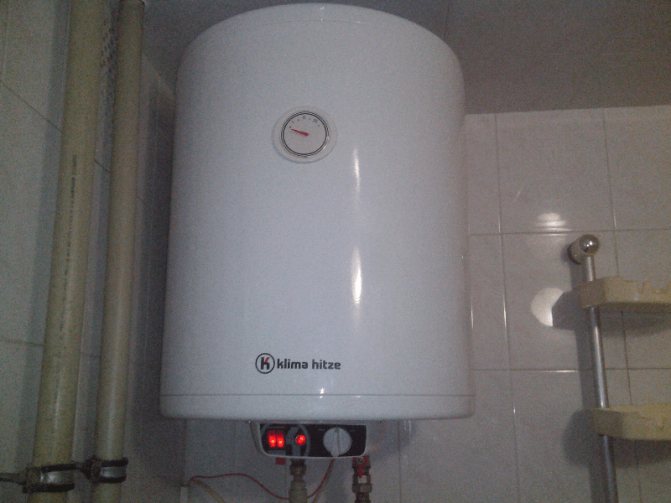

The question of how to save energy on the boiler worries many. It is no secret that any heating device - even a small kettle - consumes a lot of resources, the tariffs for which are very high. What can we say about equipment that is designed for 50, 80 or 100 liters of water. It is clear that a lot of electricity is required to heat such a volume.
Reducing DHW costs
Choosing a location for installation
Selecting the operating mode of the equipment
Cleaning the heating element
In this regard, many are looking for a way to at least slightly reduce consumption so that the availability of hot water in the house does not cost a pretty penny. Fortunately, there are several simple methods for this, which absolutely do not contradict the legislation. To use them, you do not need any specific knowledge or skills to work with electrical engineering - everything is quite simple.
The first thing to do is to make the right choice of location to install your new acquisition.The second is to play a little with the operating modes of the equipment, choosing the most advantageous scheme. The third is to pay close attention to the condition of the heating element. But let's take a closer look at everything.
Choosing a location for installation
As you know, the boiler is connected to the draw-off points - that is, for example, with mixers - using pipes. When you are not using hot water for several hours, when you open the tap, a slightly warm liquid will first pour out, and only then you will get the desired temperature. The explanation for this is very simple. The water that was heated by the boiler, but not released through the tap, remains in the section of the pipeline connecting them. During the period of inactivity, it cools down, and when the mixer is opened, it is drained.
Thus, you waste a certain amount of electricity that was wasted on heating this volume, wasted. The longer the pipe leading from the water heater to the nearest draw-off point, the more significant these losses will be. As an approximate figure, you can take 400 ml of water for each meter of the pipeline.
To avoid these, albeit not too large, losses, there is a simple way. Initially, install the boiler so that the pipe section between it and the nearest (or most frequently used) mixer is as short as possible. For example, if a water heater serves both the bathroom and the kitchen, then it is advisable to place it between them, and so that the water path to the second room is shorter - after all, the water is usually turned on there much more often.

